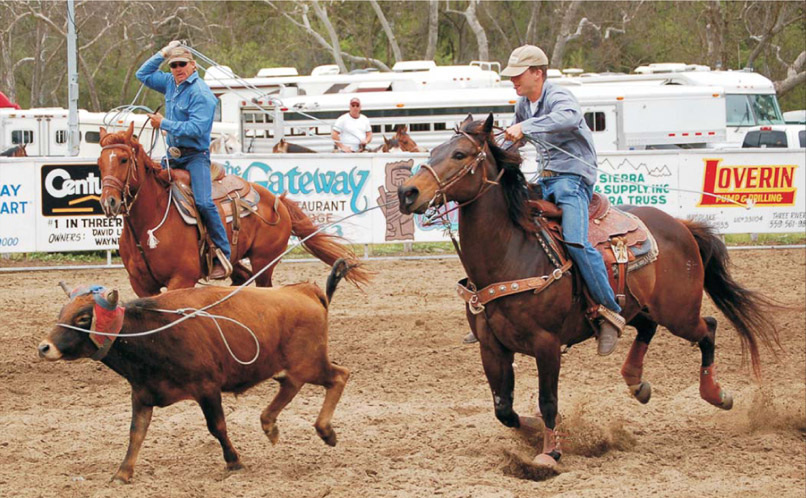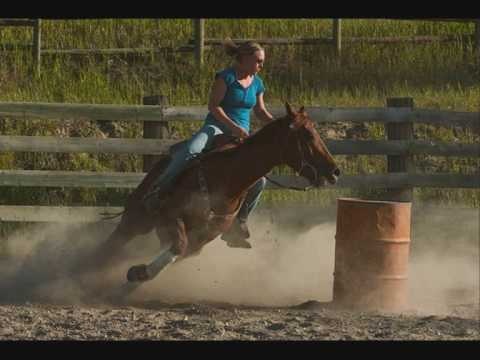Rodeo Events
This Professional Cowboy Association (PCA) sanctioned Rodeo is a highlight on the Rodeo circuit not only for all the regional competitive action but also for the breathtaking beauty of its north Georgia Mountain locations.
This year promises to be one of the best years to date with non-stop action, hilarious antics and more fun than you can handle. This year's rodeo is June 7th and 8th. So shine up you spurs, get out your times, and let's get ready to RODEO!
This year promises to be one of the best years to date with non-stop action, hilarious antics and more fun than you can handle. This year's rodeo is June 7th and 8th. So shine up you spurs, get out your times, and let's get ready to RODEO!
Events Include:
Bareback Bronc Riding
Saddle Bronc Riding
Steer Wrestling
Ladies Barrel Racing
Ladies Breakaway Roping
Tie Down Roping
Team Roping
Bull Riding
Bareback Bronc Riding
Saddle Bronc Riding
Steer Wrestling
Ladies Barrel Racing
Ladies Breakaway Roping
Tie Down Roping
Team Roping
Bull Riding
ALL horses entering R-Ranch property must have a current valid Coggins.
Bareback Bronc RidingBareback riding, developed in the rodeo arena many years ago, consistently produces some of the wildest action in the sport. A bareback rider begins his ride with his feet placed above the break of the horse's shoulder. If the cowboy's feet are not in the correct position when the horse hits the ground on its first jump out of the chute, the cowboy has failed to "mark out" the horse properly and is disqualified.
Throughout the seven-second ride, the cowboy must grasp the rigging (a handhold made of leather and rawhide) with only one hand. Optimum spurring action begins with the rider in control, his heels at the horse's neck. He then pulls his feet, toes turned outward, to the horse's withers until the cowboy's feet are nearly touching the bareback rigging. A rider is disqualified if he touches his equipment, himself or the animal with his free hand. The rider is judged on his control during the ride and on his spurring technique. The score also is based on the rider's "exposure" to the strength of the horse. In addition, the horse's performance accounts for half the potential score. |
Saddle Bronc
Rodeo's "classic" event, saddle bronco riding, has roots that run deep in the history of the Old West. Ranch hands would often gather and compete among themselves to see who could display the best style while riding unbroken horses. It was from this early competition that today's event was born. Each rider must begin his ride with his feet over the bronc's shoulders to give the horse the advantage. A rider who synchronizes his spurring action with the animal's bucking efforts will receive a high score. Other factors considered in the scoring are the cowboy's control throughout the ride, the length of this spurring stroke, and how hard the horse bucks. Model spurring action begins with the rider's feet far forward on the bronc's point of shoulder, sweeping to the back of the saddle, or "cantle," as the horse bucks. The rider then snaps his feet back to the horse's neck before its front feet hit the ground. Disqualification results if, prior to the buzzer, which sounds after eight seconds, the rider touches the animal, himself or his equipment with his free hand, if either foot slips out of a stirrup, if he drops the bronc rein, or if he fails to have his feet in the proper "mark out" position at the beginning of the ride
|
Steer Wrestling
Steer wrestling is the quickest event in rodeo. The objective of the endeavor is evident in its name: to wrestle a steer to the ground using only leverage and strength. The steer wrestler, or "bulldogger," begins his run behind, along with his "hazer," a second cowboy whose task is to keep the steer from veering away from the steer wrestler. The steer is given a head start, the length of which varies depending on the size of the arena. After the steer has reached the "score line" and the barrier is released, the steer wrestler and hazer chase the steer on their specially trained horses until the bulldogger is in position to dismount onto the racing steer. The steer wrestler slides down the right side of this horse until he can reach the steer's right horn and grasps the left horn in his left hand, then digs his heels deep into the dirt and uses leverage to bring down the steer. All this occurs in 3 to 5 seconds, depending on the size of the arena. In addition to sheer strength, timing and balance are important to the steer wrestler. The hazer also is an important factor in the equation. Without him, the setter could quickly sour a run by veering away from the steer wrestler. Many hazers also supply horses for the steer wrestlers. If the steer wrestler places, the hazer receives a share of the payoff. If not, both go home empty-handed.
|
Bull Riding
Unlike the other rough stock contestants, bull riders are not required to spur. No wonder. It's usually impressive enough to remain seated for eight seconds on an animal that may weigh more than a ton and is as quick as he is big. Upper body control and strong legs are essential to riding bulls. The rider tries to remain forward, or "over his hand," at all times. Leaning back could cause him to be whipped forward when the bull bucks. Judges watch for good body position and other factors, including use of the free arm and spurring action. Although not required, spurring will add points to a rider's score. As in all the riding events, half of the score in bull riding is determined by the contestant's performance and the other half is based on the animal's efforts. A bull rider will be disqualified for touching the animal, himself or his equipment with his free hand.
|
Tie-Down Roping (Calf Roping)
More than any other event in professional rodeo, tie-down roping has roots dating back to the Old West. When a calf was sick or injured, it had to be caught and immobilized quickly for treatment. Ranch hands prided themselves on how fast they could rope and tie calves, and soon they began informal contests. Being quick and accurate with a lasso aren't the only requirements in calf roping. A successful roper also must be an experienced horseman and a fast sprinter. After giving the calf a predestinated head start, the horse and rider give chase. As the cowboy throws his loop, the horse comes to a stop. After catching the calf, the cowboy dismounts, runs to the calf, throws it to the ground by hand (called "flanking") and ties any three legs together using a "pigging sting" he has carried in his teeth throughout the run. While the contestant is accomplishing all this, the horse must keep the slack out of the rope, but not pull it tight enough to drag the calf. If the calf is not standing when the roper reaches it, the cowboy must allow the calf to stand before making the tie. When the roper has completed this tie, he throws his hands in the air as a signal to the flag judge. He then remounts his horse and rides toward the calf, making the rope slack.
|
Team Roping
In rodeo's only true team event, two ropers, a "header" and a "heeler", work together to catch a steer. The header is the first cowboy out of the box. He may rope the steer around the head and one horn, around the neck or around both horns, which are specially wrapped for the event. As with all timed events, if the header fails to give the animal its allotted head start, a 10-second penalty is added to the total time. After making his catch, the header rides to the left, taking the steer in tow. The heeler moves in and ropes both hind legs. Catching only one hind leg results in a five-second penalty. If the heeler tosses his loop before the header has changed the direction of the steer and has the animal moving forward, it's called a "cross-fire," and it results in disqualification. The clock is stopped when the slack has been taken out of both ropes and the contestants are facing each other.
|
Ladies Barrell RacingBarrel racing is a rodeo event in which a horse and rider attempt to complete a clover-leaf pattern around preset barrels in the fastest time. Though both boys and girls compete at the youth level and men compete in some amateur venues, in collegiate and professional ranks, it is primarily a rodeo event for women. It
combines the horse's athletic ability and the horsemanship skills of a rider in order to safely and successfully maneuver a horse through a clover leaf pattern around three barrels (typically three fifty-five gallon metal or plastic drums) placed in a triangle in the center of an arena. In timed rodeo events, the purpose is to make a run as fast as possible, while the time is being clocked either by an electronic eye, (a device using a laser system to record times), or by an arena attendant or judge who manually takes the time using the eye and a flag to let a clocker know when to hit the timer stop though this last method is more commonly seen in local and non-professional events. The timer begins when horse and rider cross the start line, and ends when the barrel pattern has been successfully executed and horse and rider cross the finish line. The rider's time depends on several factors, most commonly the horse's physical and mental condition, the rider's horsemanship abilities, and the type of ground or footing (the quality, depth, content, etc. of the sand or dirt in the arena). |
Ladies Breakaway RopingLadies breakaway roping is a newly sanctioned event for PCA. The event has been popular for many years in High School and College Rodeo.
Similar to tie down roping, success depends greatly on the teamwork of the contestant and her horse. The difference is that the ladies do not rope hard and fast. The tail end of the cowgirls rope is tied with string to the saddle horn, the loop of the rope must pass over the head of the calf, come tight to the calf and break the rope away from the contestants saddle horn. Once the rope breaks away the judge drops his flag and a time is given. As in all timed events a 10 second penalty is added if the contestant breaks the barrier at the beginning of the run. Ladies Breakaway is fast becoming a popular event to watch at PCA rodeos. |







